Leading Today's Business Schools: Insights From Deans
February 2024
The dynamics of leadership are undergoing significant shifts and the spotlight intensifies on those at the helm of educational institutions. To track these developments, every three years AACSB gathers insights from the leaders at member schools and delves into the characteristics, challenges, and opportunities of the multifaceted role of the business school dean.
This report brings together the voices of 434 deans and 36 interim deans across 64 countries. The narrative is enriched by the relevant perspectives of 143 senior business school administrators spanning 23 countries. These collective insights offer a unique snapshot of the current state of business school leadership. The report highlights the current capabilities and areas for growth, as well as the obstacles deans encounter and the support they seek.
For a more detailed exploration of the demographics and other findings from the survey, please visit the companion Deans Survey 2023–24 Overview Report and Senior Administrators 2023–24 Overview Report.
Learn more about the sponsor.
Key Takeaways
This year's survey revealed many interesting insights into what it takes to be a business school dean. Here are a few of the key takeaways.
- Diversity among deans is gradually evolving. Thirty percent of surveyed deans identify as female, up from 26 percent in 2020–21. In the U.S., the racial and ethnic tapestry is also showing glimpses of change as the proportion of white, non-Hispanic deans begins to mirror population levels. The representation of Asian or Pacific Islander deans has doubled over six years, while other race/ethnicity segments are growing slightly or holding steady.
- The role of associate dean is a crucial stepping stone to becoming a dean, with some variation by region and gender. The journey of male deans tends to be more uniform compared to their female counterparts. Notably, 21 percent of female deans have ascended to their positions from interim dean roles, compared to only 12 percent of male deans. A mere 13 percent of female deans have advanced from the department head/chair role, whereas 25 percent of first-time male deans came from this role. In the Asia Pacific and Europe, Middle East, and Africa regions, the positions of department head/chair and vice dean are more commonly seen as pivotal roles on the path to deanship.
- Deans prioritize a mix of interpersonal skills and tangible, market-relevant expertise in their roles. They express a desire to enhance their abilities in fundraising, communication, and strategic planning, with fundraising particularly emphasized by deans from Northern America. Respondents chose student recruitment and retention as a critical priority, whereas they ranked government and political engagement lower on their priority lists and areas for skill development, despite acknowledging it as an increasingly significant challenge.
- Deans struggle with work-life balance and finding time for professional development. While only 8 percent of deans report having enough time to pursue professional development and juggle the diverse demands of their role, an impressive 83 percent still find their work rewarding and feel optimistic about their career progression. Despite public perception of educational leadership as a brutal job, the average tenure of business school deans has slightly decreased over the past three years.
- Central to the experience of new deans is receiving mentorship and exchanging best practices with colleagues. Resources related to staff/faculty management and fundraising expertise are particularly sought after by first-time deans at the beginning of their tenure. In Latin America and the Caribbean, over half of dean respondents indicated a need to better understand what their role would entail, significantly higher than deans in other regions. For deans in Asia, meeting accreditation standards is highlighted as a critical area where additional support and preparation could greatly assist those new to the position.
Today's Business School Dean
Notably, 61 percent of Deans Survey respondents are navigating their first deanship, and 53 percent are classified as “experienced deans,” bringing the wisdom gained from multiple deanships or extended tenures in their first deanship dating back to 2017 or earlier. This blend of fresh energy and seasoned expertise paints an illuminating picture of the leadership landscape in today’s business schools.
How is the composition of today’s business school dean changing? Below is a snapshot of some of the characteristics of business school deans, as reported to AACSB in its 2020–21 and 2023–24 surveys.
Deans Today vs. 3 Years Ago
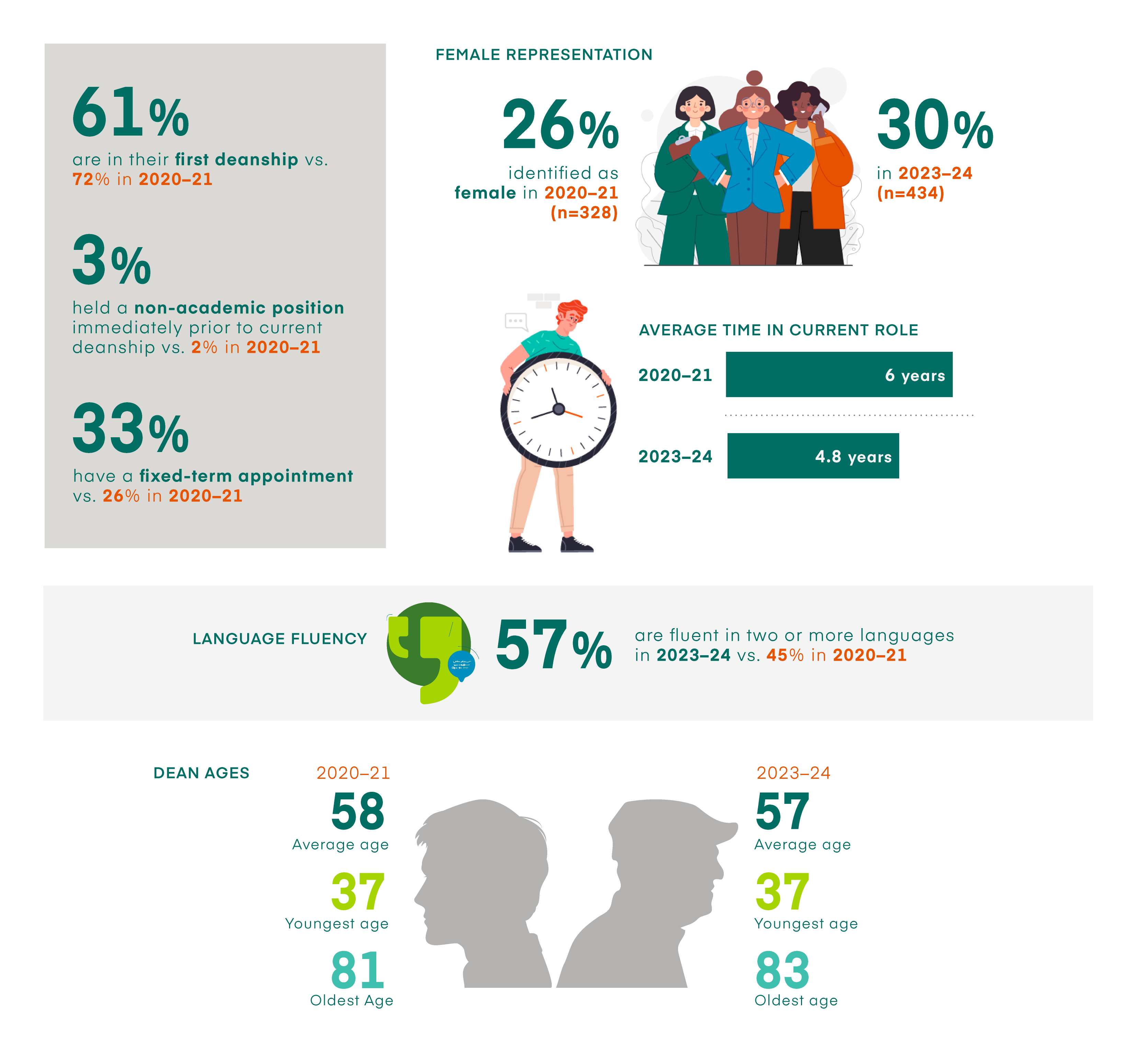
*For those who indicated male or female gender. The category of “Other (specify)” was not selected by any respondents.
A notable trend is the increase in female representation among surveyed deans, rising from 26 percent to 30 percent. Among today’s female deans, 69 percent are in their first deanship, compared to 57 percent of their male counterparts.
Race/Ethnicity Composition of U.S. Deans
A look back to the 2017–18 data reveals modest growth in racial and ethnic diversity among U.S. deans. While these changes signal progress, more development in diversity among this group of deans is needed.
Changes in Race/Ethnicity Composition of U.S. Deans
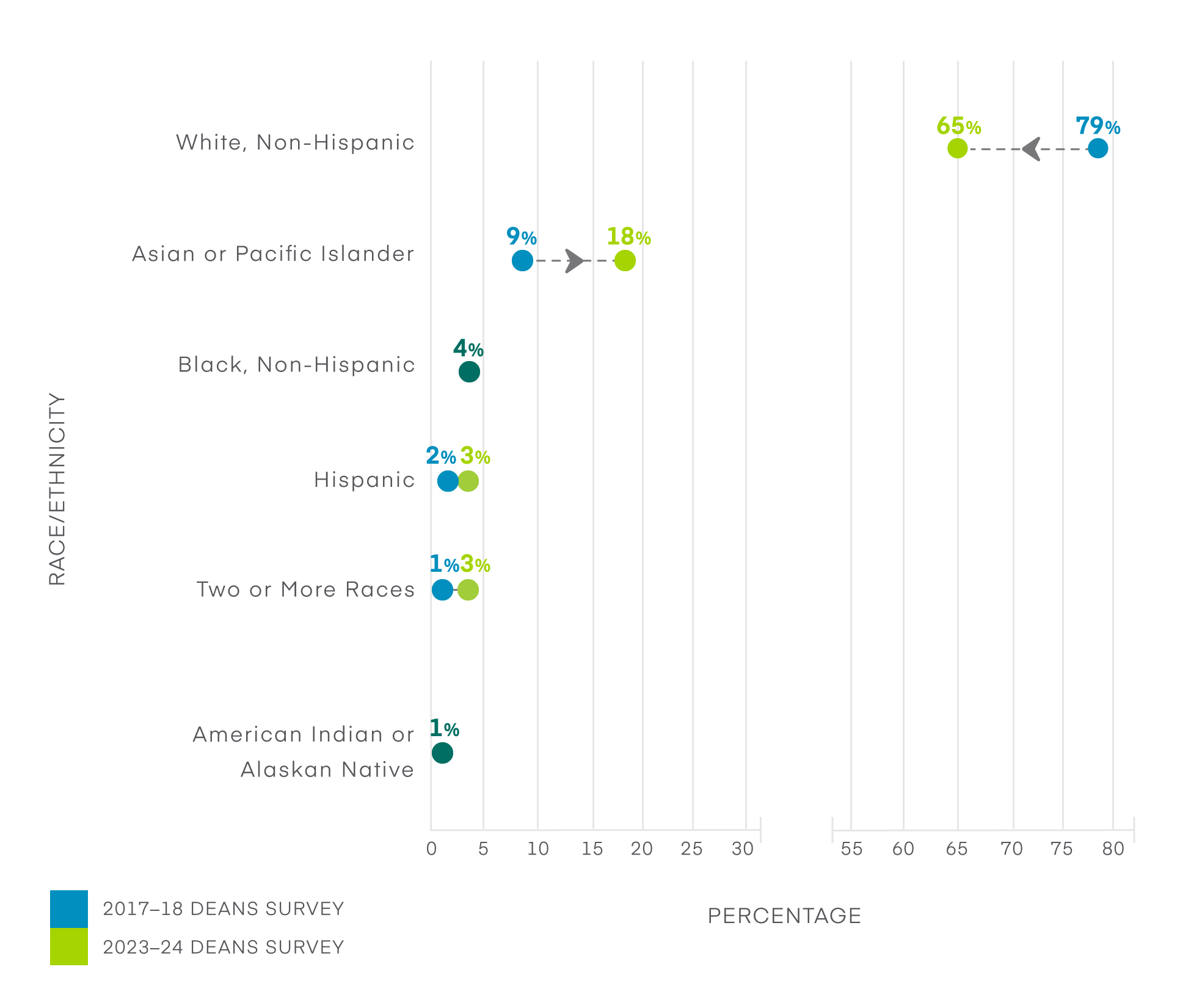
2023–24 Deans Survey vs. 2023 U.S. Census Population Data
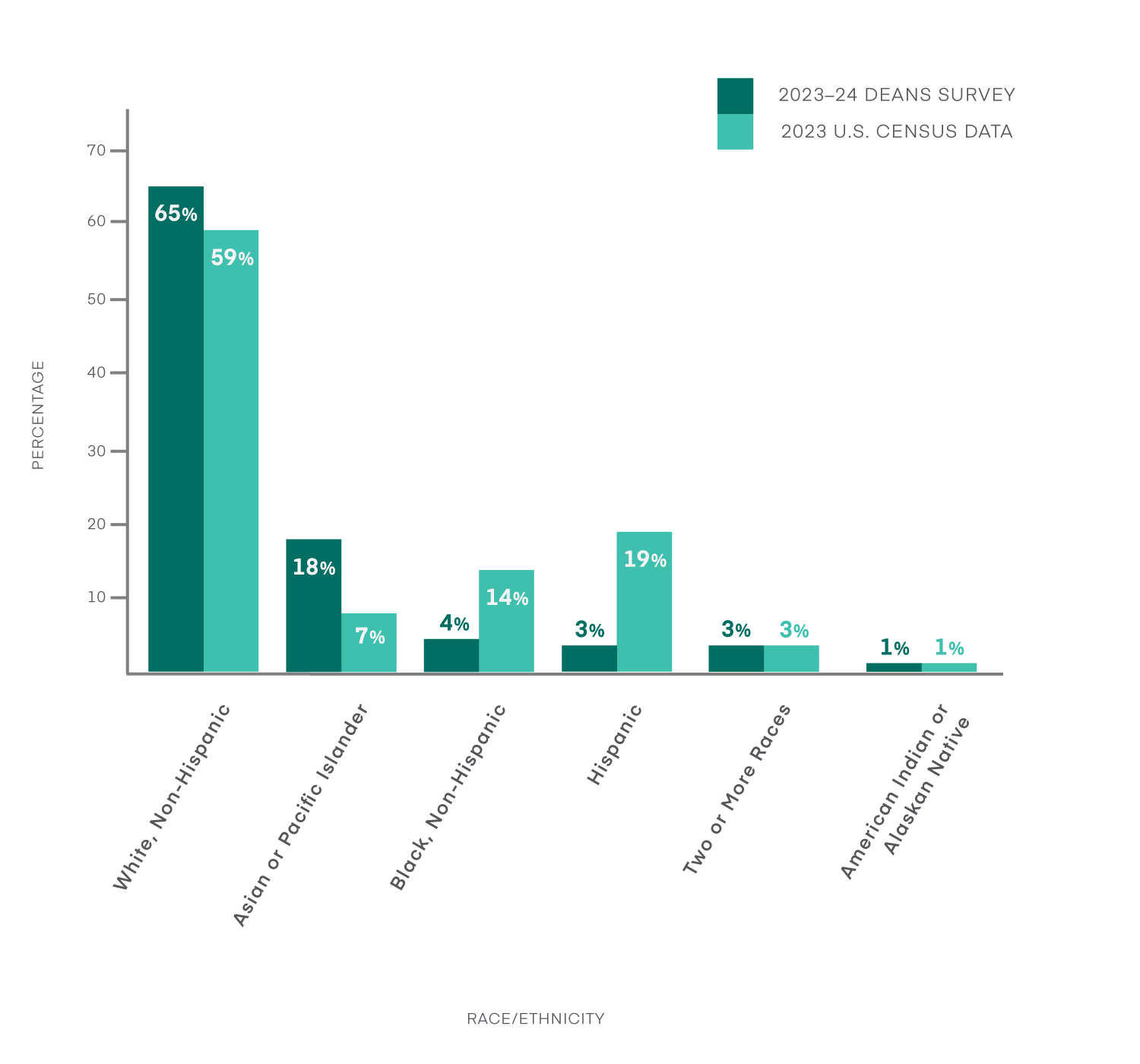
The representation of white, non-Hispanic deans largely reflects the group’s demographic presence in the U.S. population. Additionally, the number of Asian or Pacific Islander deans has seen a notable increase in the six-year period, doubling in proportion and outpacing population growth of this group in the U.S . While there hasn't been a decrease in the number of Black, non-Hispanic, and Hispanic deans, there’s still room for growth to enhance their representation, aligning more closely with the broader U.S. population demographics.
Dean Salaries
The Deans Survey does not collect salary data, but AACSB’s Staff Compensation and Demographics Survey data offer insights on how dean salaries have changed from three years prior.
Distribution of Dean Salaries 2019–20 vs. 2022–23
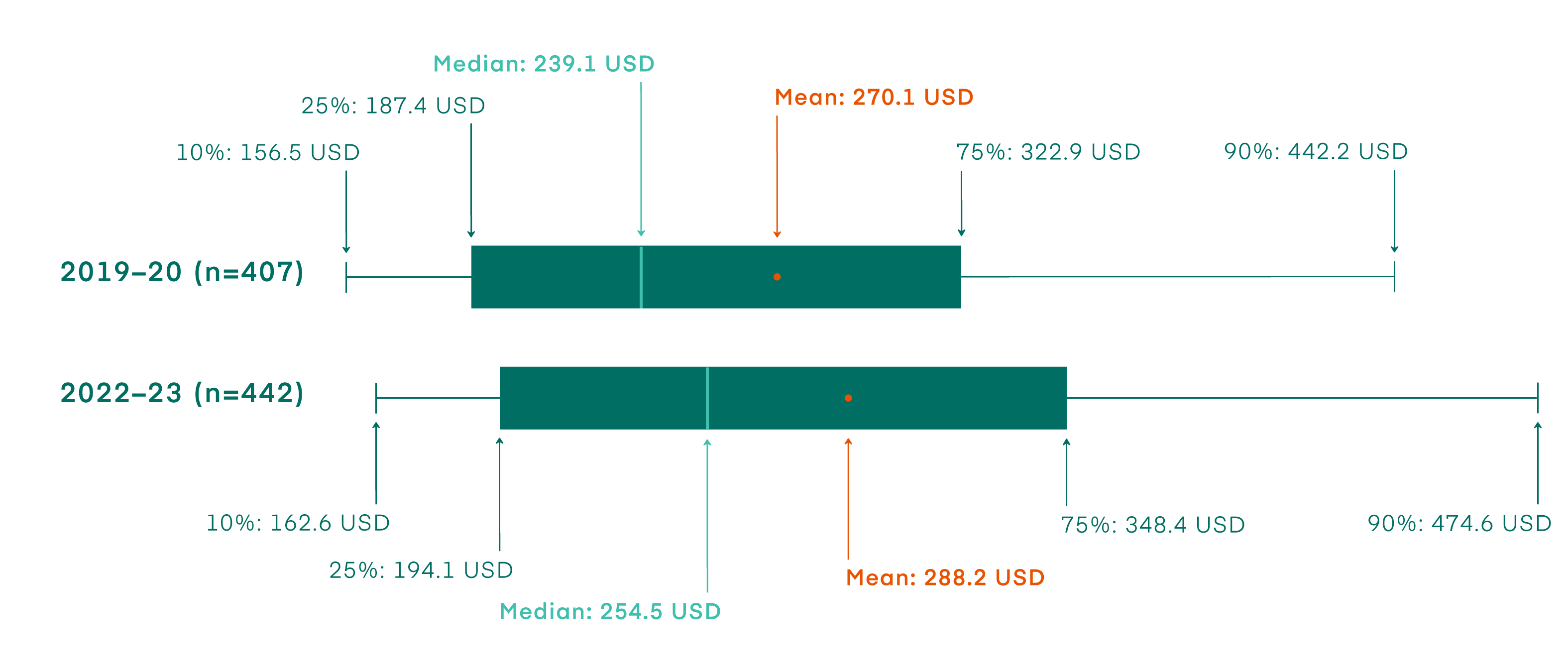
*Based on 12-month salary data reported to AACSB Staff Compensation and Demographics Survey by AACSB-accredited schools for respective years.
Journey to the Top: Pathways to Becoming a Business School Dean
In the dynamic landscape of business school leadership, the routes to deanship may seem uniform at first glance, but a closer look shows some thought-provoking variety among certain dean groups. While the largest proportion (27 percent) of today’s deans have transitioned from a previous deanship, the roles of associate dean and department head/chair emerge as key springboards for those stepping into their first deanship.
Top 5 Positions Immediately Prior to First Deanship
| All Deans (n=443) | Female Deans (n=130) | Male Deans (n=305) | |
| #1 | Associate Dean (26%) | Associate Dean (27%) |
Associate Dean (25%); Department Chair/Head (25%) |
| #2 | Department Chair/Head (22%) | Interim/Acting Dean (21%) | Interim/Acting Dean (12%); Vice Dean (12%) |
| #3 | Interim/Acting Dean (15%) | Department Chair/Head (13%) |
Other Academic (5%) |
| #4 | Vice Dean (11%) | Other Academic (10%) |
Faculty Member (7%) |
| #5 | Other Academic (9%) | Vice Dean (8%); Faculty Member (8%) |
Program Director (5%) |
Delving into the gender dynamics, the journey of male deans often follows a more uniform pattern than that of female deans. Half of male respondents have ascended from either the associate dean or department head/chair position, each accounting for 25 percent. Additionally, about one in four have honed their leadership preparation as interim deans or vice deans.
In contrast, the path of female deans paints a more diverse and dynamic picture. While the associate dean role is also a primary pathway for them, a significant 21 percent have leveraged the interim dean position as a launchpad—a notable increase compared to 12 percent among their male counterparts. Only 13 percent have risen from department head/chair roles, underscoring a distinct divergence from the male trajectory (25 percent of first-time male deans). Data from 2020–21 echo this trend, highlighting the interim position as a critical steppingstone for female deans. This trend could point to various underlying factors: perhaps these leaders are surpassing expectations in temporary roles or are more frequently tested in interim capacities. Female deans also show a marginally higher tendency to transition from non-academic roles, adding another layer to their diverse journey to leadership.
Findings suggest a more consistent pattern in the career trajectories of male deans, hinting at their adherence to a more traditional and linear progression through academic ranks. In contrast, the career paths of female deans imply a broader range of experiences and possibly less conventional routes on their journey to becoming deans.
A regional view presents additional differences. In the Asia Pacific and Europe, Middle East, and Africa (EMEA) regions, the associate dean pathway is not as prevalent. Here, the roles of department head/chair and vice dean take precedence. This regional variance might stem from differences in organizational structures or terminologies but is nevertheless a critical factor in understanding the global landscape of business school leadership.
Only 29% of senior business school administrators are interested in deanship.
Senior Administrators Share Reasons Against Pursuing DeanshipGiven the high number of first-time deans transitioning from associate dean positions, we explored data from our survey of senior business school administrators where respondents indicated their level of interest in pursuing a deanship. While the motivations of these administrators differ due to personal factors such as imminent retirement or indecision, three key reasons emerged from those with clear opinions on why they are not inclined toward a deanship: Not a good fit for the role from a skill and/or personality perspective, particularly related to fundraising expectations.
Faculty status and research qualifications required of deans at certain institutions prevent non-PhD administrators from pursuing the role, yet administrators with academic roles are reluctant to sacrifice their research time to fulfill dean responsibilities.
A turbulent environment and the increasingly political nature of academic leadership create an aversion to what some consider a “brutal job.”
|
How Current Deans Obtained Their Roles
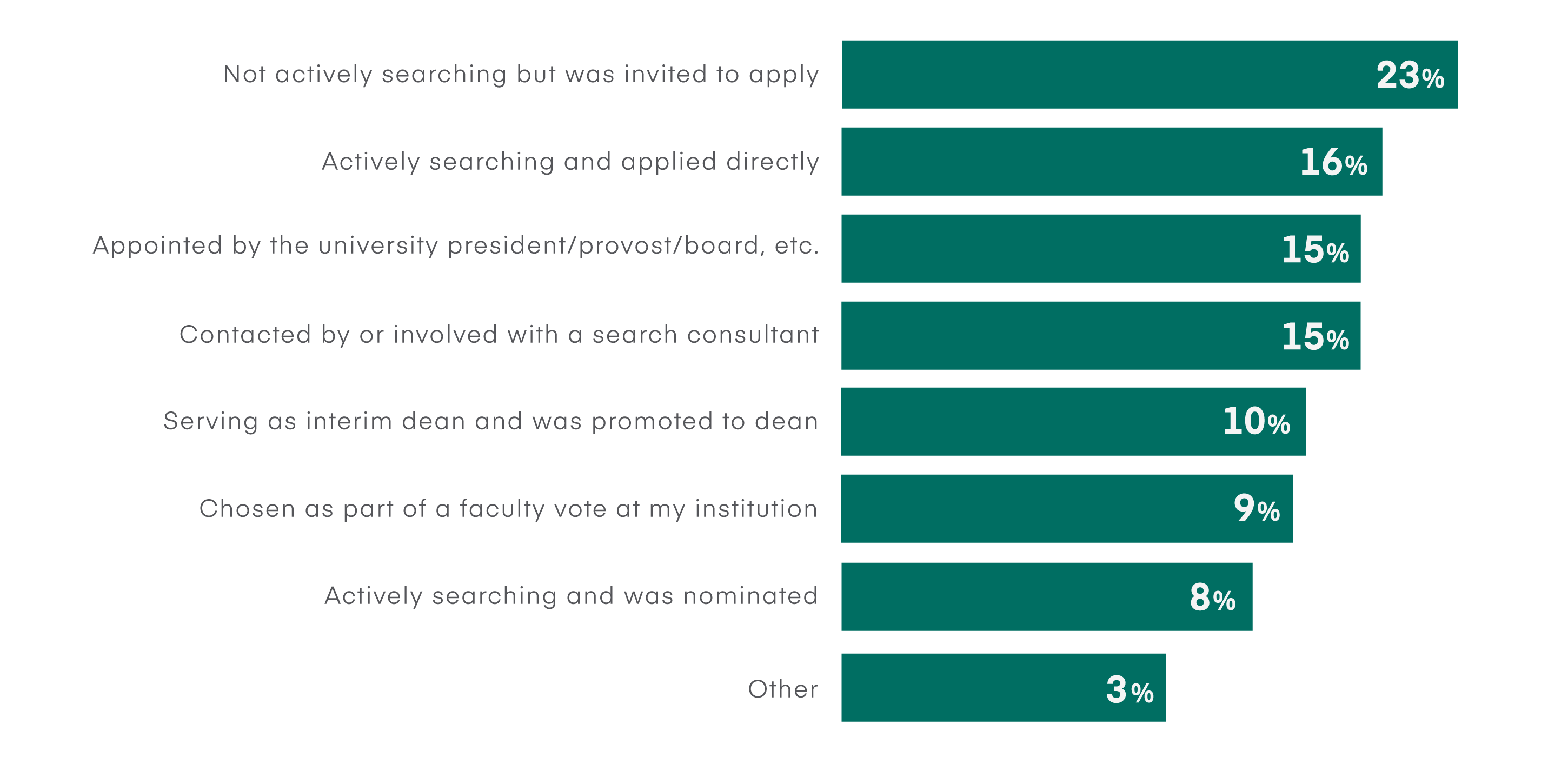
This year’s survey reveals that deans acquired their roles through different methods. The predominant approach was an invitation to apply, even though the individuals were not actively seeking the dean position. Notably, a higher percentage of male deans (26 percent) followed this path compared to female deans (16 percent). The most frequent method for female deans was actively seeking and directly applying for the position (20 percent), and a close second was engagement with or contact from a search consultant (19 percent).
The Value of Non-Academic Experience in a Dean’s Role
While the higher education environment is distinct from a typical business setting, leaders with non-academic professional backgrounds can contribute uniquely to managing a business school. They bring a variety of qualities, from social savviness to a broader network of experts to alternative team-building strategies.
66% of deans have some non-academic work experience. Of these, nearly 2/3 have up to a decade of professional experience.
Years of Nonacademic Experience
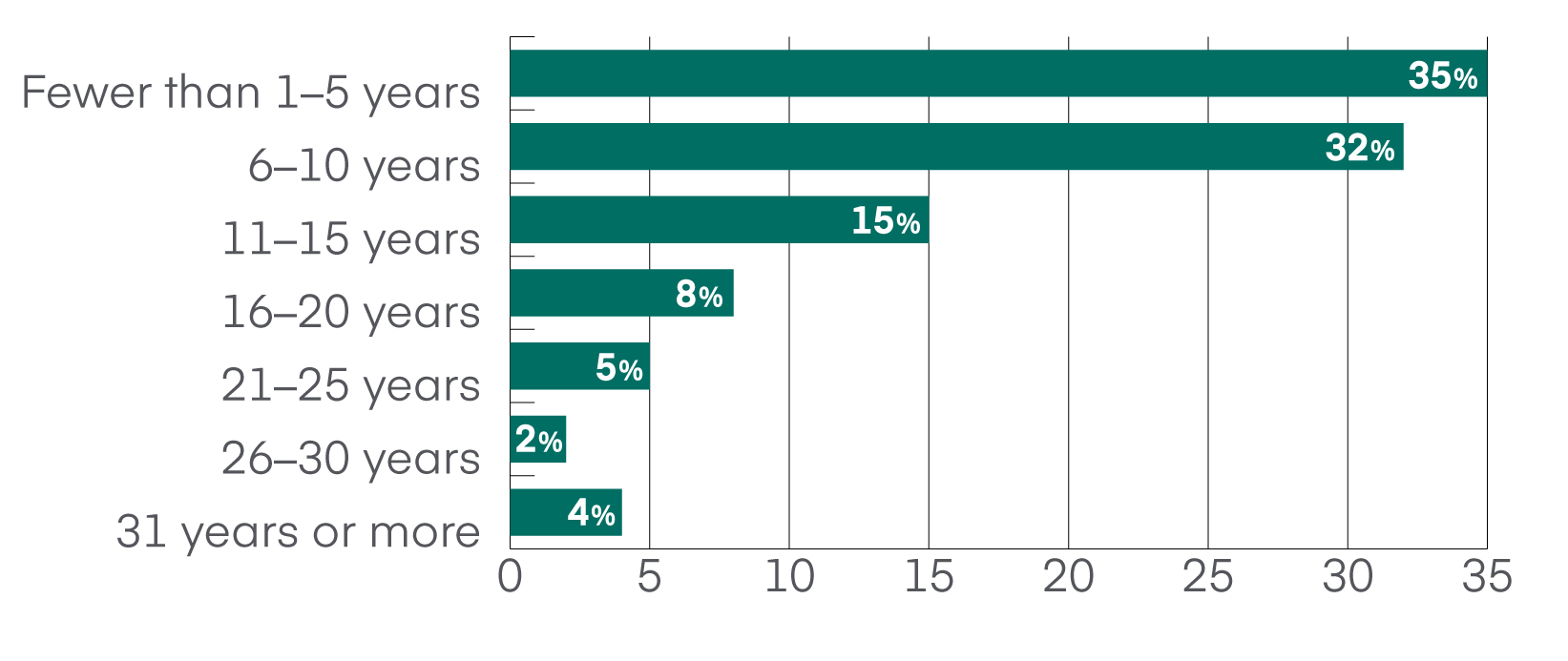
Among deans with non-academic professional experience, the majority, at 85 percent, have spent most of their careers in a business organization, regardless of their position. Meanwhile, 20 percent have experience working in government settings, and 18 percent have backgrounds in NGOs or nonprofits. Forty-three percent of these deans came into the dean role with some form of executive experience gained from a business or NGO/nonprofit organization. Additionally, a significant portion, 43 percent, of these deans bring executive-level experience to their roles.
5 Ways Deans Benefit From Professional Working Experience
Sixty-five percent of deans with professional working experience indicated that their non-academic roles were helpful or very helpful to their dean role. The following are some of the key ways these deans believe experiences and skills gained from their previous roles have benefited them:
- Fiscal Leadership: Guiding financial health through effective budget management, interpreting profit and loss statements, making savvy financial choices, and strategically investing in growth areas.
- Empowering Leadership: Cultivating a dynamic, growth-focused culture, enhancing team cohesion, nurturing continuous professional development, and driving academic distinction by fostering organizational adaptability.
- Practical Business Application: Bridging academic theory with real-world business scenarios, ensuring that educational content is aligned with current business needs and challenges.
- Strategic Execution and Impact Analysis: Adopting a practical approach to strategy formulation, setting attainable objectives, and rigorously evaluating outcomes to improve the institution’s offerings and influence.
- Strategic Communication and Influential Networks: Mastering strategic communication, including negotiation and consensus-building, conveying the institution’s vision effectively to stakeholders, and leveraging a broad network in the business community that informs decision-making.
Beyond Deanship
Recent media coverage has highlighted a trend of increased turnover and shorter tenures in leadership roles across higher education, not just in business schools. AACSB data indicates a slight decline in the average tenure of deans, yet the reasons for leaving these positions remain largely unchanged. As the dean’s role becomes more complex, it will be crucial to observe how this complexity affects the duration of deans’ tenure.
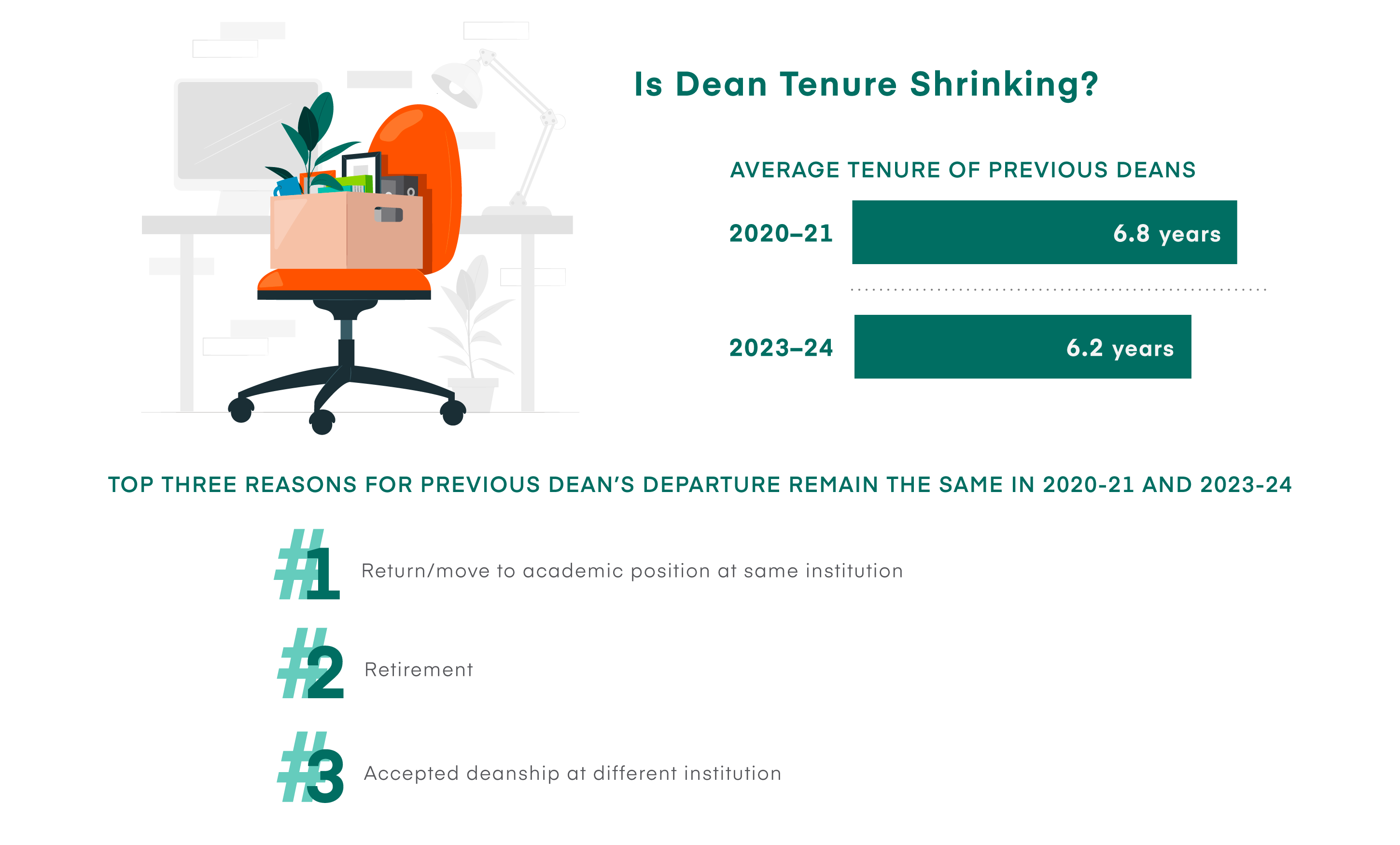
*In the 2020–21 survey version, this option was worded, “Moved to another non-dean leadership position in academia.”
Top 5 Areas of Pursuit After Deanship
This year’s group of dean respondents is a diverse mix of individuals at various stages in their careers. However, we were eager to learn of their potential plans and endeavors after concluding their tenures as deans.

Recognizing that the survey allowed respondents to choose several options from a list of possible future paths, staying connected with the academic world in some form is a prominent consideration for many. Indeed, 70 percent of deans expressed their intention to engage in at least one academic activity post-deanship, whether exclusively or alongside another position, even if that position is outside of academia.
Priorities, Strengths, and Opportunities for Development
The expectations and responsibilities of business school deans are changing to match the dynamic nature of modern higher education, and as such, they will need certain essential skills to perform their roles effectively. This section delves into the critical skills, priorities, and development opportunities for deans. We explore their perceived strengths, areas needing enhancement, and the broader view of what constitutes an effective dean in today’s educational landscape. These insights offer a window into the competencies that are shaping effective leadership in business schools.

Joyce Strawser
Dean, Stillman School of Business
Seton Hall University
Deans were asked to rate a series of activities on their priority level over the next 12 months, of which the following areas emerged to the top.
| Top 5 Priority Activities of Deans in the Next Year | |
| #1 | Student recruitment/retention |
| #2 | Strategic planning |
| #3 | Accreditation management/continuous improvement |
| #4 | Financial performance/budget management |
| #5 | Societal impact initiatives |
Top Competency Areas of Effective Deans
In an open-ended section of the survey, deans identified key competencies or skills of effective deans. The skills most mentioned include strategic planning/thinking, communication, leadership, faculty/people management, fundraising, and emotional intelligence/empathy.
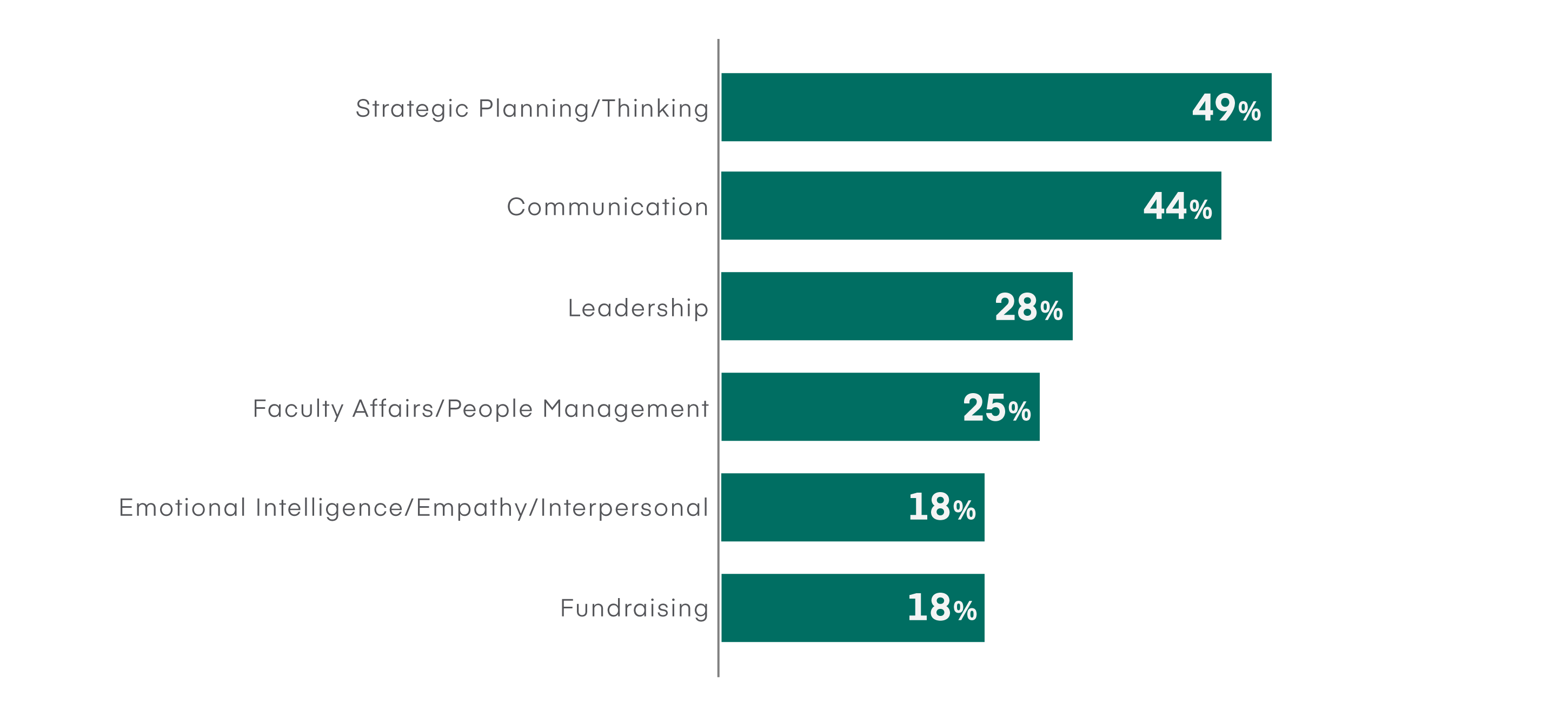
These areas are consistently highlighted across genders and experience levels. Notably, a higher percentage of female deans (54 percent) emphasized strategic planning/thinking compared to male deans (48 percent). Also, fewer female deans than male deans highlighted faculty/people management as a top competency.
Senior administrators in business schools collaborate extensively with their dean, playing a critical role in executing their dean’s strategic vision. Their insights are vital to deans in identifying areas for professional growth. Encouragingly, our surveys show a strong alignment between deans and senior administrators on the key qualities of an effective dean, with both groups identifying the same top five competencies.
Competencies Deans Would Like to Develop More
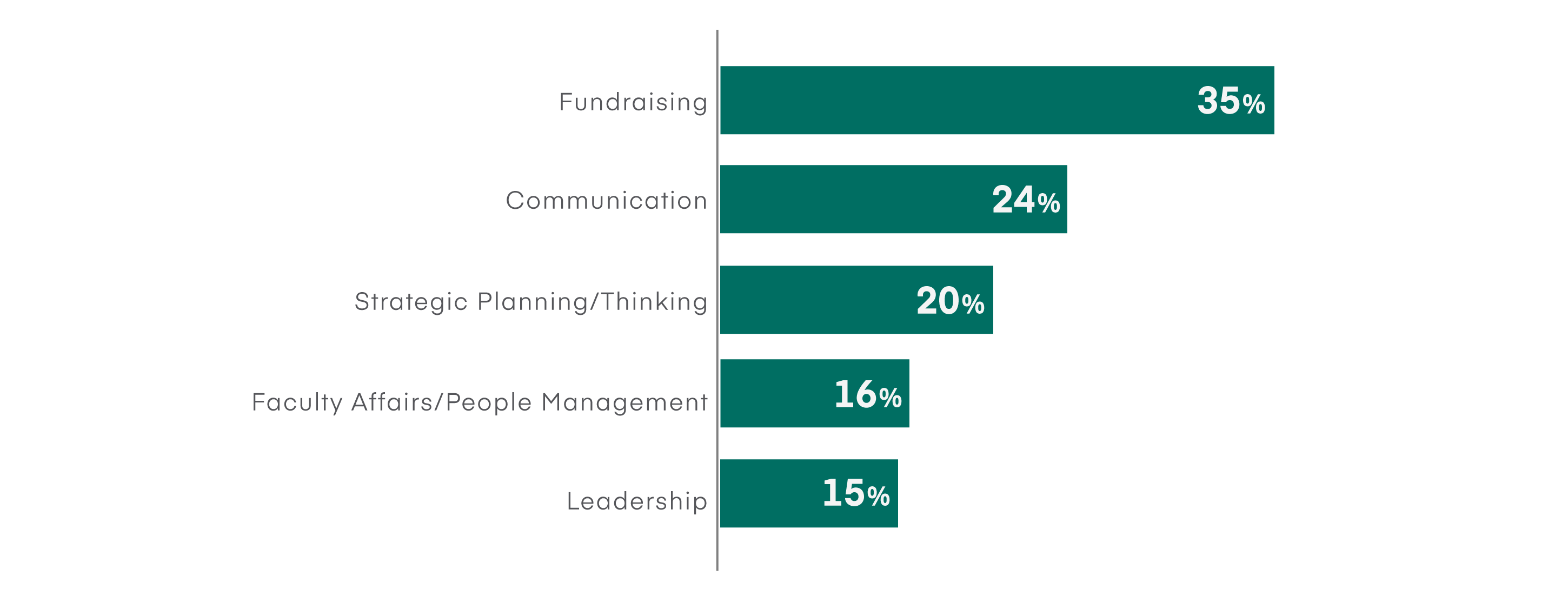
When asked about competencies they would like to develop more, deans identified the same five skills, but they overall gave less emphasis to emotional intelligence/empathy/interpersonal skills, with only 6 percent prioritizing that area. This decline could mean that while deemed important, these skills are perceived as either challenging to develop formally or already well-mastered. It is important to note that while fundraising emerges as a top area for development, this result is largely due to the disproportionately high representation of Northern American deans, 48 percent of whom would like to prioritize developing skills in this area, compared to only 16 percent of deans in both the Asia Pacific and EMEA regions.
24% of deans have a fundraising goal for which they are held accountable annually; however, the larger the school, the greater the proportion of deans with formal fundraising goals:
Percentage of Deans With Fundraising Goal by School Size
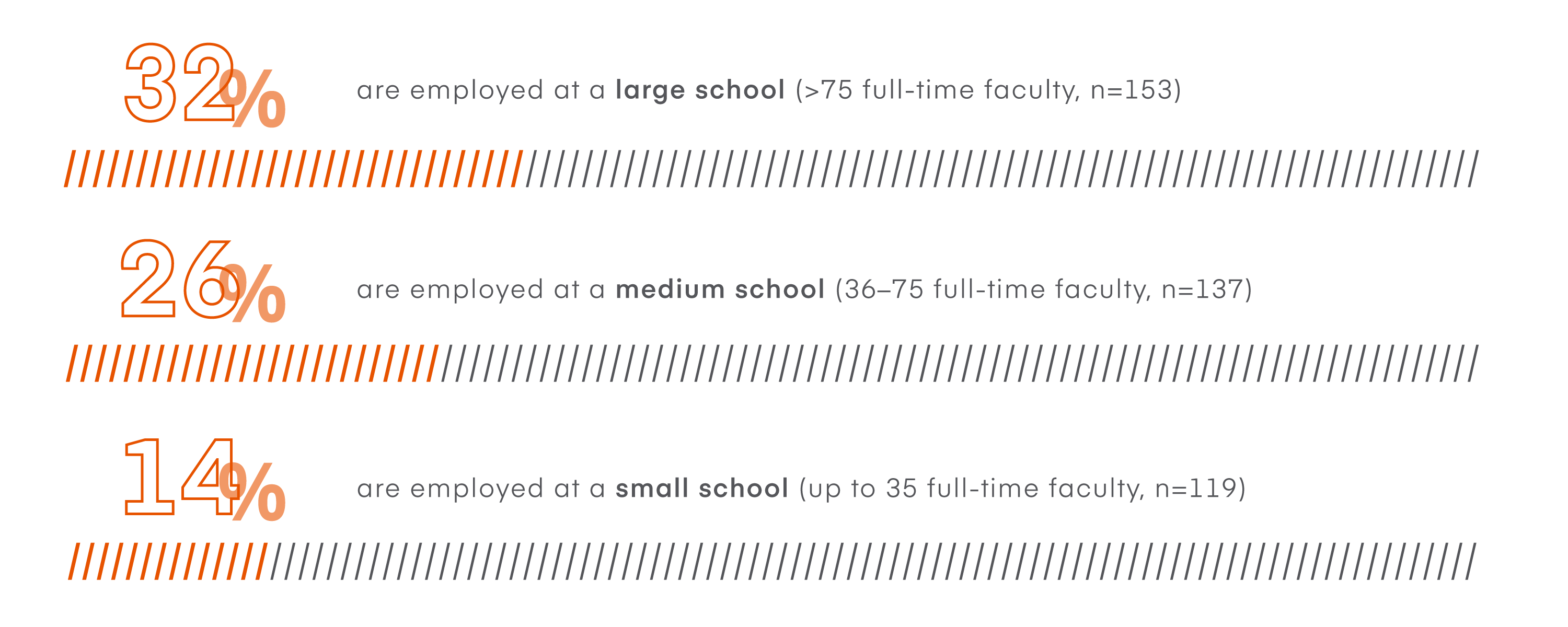
*School size is determined by the number of full-time faculty members reported by the institution on the Staff Compensation and Demographics Survey. Twenty-four schools from the Deans Survey were not captured in this analysis, as they did not report full-time faculty.
The Relationship Between Priority, Proficiency, and Desire for Development in Key Skill Areas
Analyzing Deanship Activities: A Look at Proficiency, Priority, and Desire for Development
For optimal viewing experience, view on Tableau.
Explore the Chart |
|---|
|
Survey respondents were asked to rate a series of typical duties of a business school dean on a scale of 1 to 5 (where 1 is low and 5 is high). This involved assessing each activity’s level of priority for the upcoming year, their perceived current level of proficiency in that activity, and their desire to improve in that activity. The scatter plot displays weighted average ratings on this scale. The graph highlights the relationship between the priority of each skill/activity, current proficiency level, and desire for development, revealing insight into deans’ skill development preferences. The interactive chart offers four scatter plot perspectives categorized by skill area, dean type (experienced or new), geographical region, and school size, which can be toggled through at the top of the chart. The y-axis indicates respondents’ level of desire for enhancing a particular skill/activity, while the x-axis shows its priority level. Dot sizes represent proficiency levels in each skill, with larger dots denoting greater proficiency. Different skills/activities are color-coded, as detailed in the chart’s legend. Four “zones” are included in each quadrant to illustrate where skills fall in terms of their priority level and deans’ desire for further development in the skill:
|
- All administrative activities have above-average priority. Proficiency in these activities is also consistent across specific areas, apart from brand reputation, communications, and crisis management. Financial performance/budget management represents an area of less desired development compared to other administrative activities.
- External relations activities overall have the least priority and least skill proficiency among deans, aside from business community engagement/networking, which represents a priority area for development. As is seen across all views of the scatter plot, government/political engagement is a hidden opportunity area for deans, especially given the below-average proficiency in that activity compared to others.
- The two faculty-focused skill areas—faculty recruitment and faculty management and development—show similar proficiency levels but opposing desires for development and priority, with the latter representing a bigger focus area for deans.
- Student recruitment/retention stands out as the highest priority area of deans and the second most desired area for development. Further, deans rate their proficiency here slightly below average, suggesting that it is an important area for needed resources.
- Deans are confident in their curriculum/program development competency—a sentiment that holds true regardless of dean experience or school size.
- New deans typically exhibit a greater need and eagerness for professional development, while those with more experience dominate the comfort zone and tend to be more confident in their skills.
- Fundraising is identified as an area where deans, regardless of their tenure, acknowledge the need for further skill enhancement.
- Deans with more experience demonstrate a higher level of proficiency in managing accreditation and continuous improvement processes.
- Deans, irrespective of their experience, show a comparable interest in improving skills related to societal impact initiatives as well as in branding or communications and crisis management.
- Deans in the Asia Pacific region, while confident in their proficiency across most activities, display the highest eagerness for professional development. They consider themselves less proficient in government/political engagement and fundraising/endowment, areas they also deem as lower in priority.
- In contrast, deans in the Americas report proficiency in many activities but have a lower interest in enhancing skills they already possess. For them, fundraising/endowment and student recruitment/retention are key areas for priority and development. Fundraising/endowment is a less prioritized area for EMEA deans, which is reflected in their lower proficiency and interest in developing this skill.
- Government/political engagement emerges as a potential area for growth across all regions, marked by low proficiency, low priority, and low desire for development, despite being identified as an emerging challenge by the deans.
- Across all regions, there is a strong focus on societal impact initiatives, with high priority and high desire for development, especially in the Americas and EMEA, despite a lower perceived proficiency in these areas.
- Deans in Asia Pacific rate similar proficiency in curriculum/program development as deans in other regions but show a greater interest in development in this area. Faculty recruitment is also of greater priority and an elevated area for development compared to deans in EMEA and the Americas.
- Deans from smaller institutions tend to have a higher interest in professional growth, especially in areas of student recruitment and retention. This is a key focus for deans at all sizes of schools, but it's particularly pronounced at smaller schools.
- For deans across all school sizes, faculty recruitment is seen as a lower priority. Deans at smaller schools often consider themselves more adept in this area compared to their counterparts at medium and large schools.
- At larger schools, while strategic planning is the top priority for deans, there’s a notable eagerness to enhance skills in societal impact initiatives. Deans at these schools overall show lower desire for development compared to deans at small and medium schools, with many activity areas rating below average.
- Deans at medium-sized schools primarily seek to improve their abilities in overseeing brand reputation, communication strategies, and crisis management.
Other Top Priority Areas |
|
|---|---|
|
|
Development Interests Among Senior Administrators Looking to Pursue Deanship
Participants in the Senior Administrator Survey interested in becoming deans were asked to assess their proficiency in skills typically needed to perform the dean role, and their eagerness to develop them. Within this group, activities related to external relations (i.e., fundraising, networking with academic and business communities, alumni engagement, and government or political involvement) emerged as areas with below-average proficiency. Engaging with the business community was highlighted as the top area administrators aim to enhance. Fundraising, where proficiency was the lowest, marked the largest discrepancy between current ability and desire for skill development, indicating a key opportunity for professional development.
Navigating a Complex Landscape
Leadership in any capacity or in any organization comes with distinct challenges and expectations, a reality reflected in the abundance of articles, books, and development opportunities available in the field. Higher education has recently become central in this discussion. Leaders must satisfy the needs of various stakeholders, including students, donors, parents, faculty, government, and political entities, while also dealing with increased scrutiny about the value of higher education. Although not specific to business schools, a recent article in The Chronicle of Higher Education captures some of the sentiment around educational leadership as a career in its title alone: “You Could Not Pay Me Enough to Be a College President: Soon Enough, the Capable Few Won’t Want the Job Either.”
But what are some of the challenges facing business school deans specifically, and what are the resources they seek?

Claudia Girardone
Dean, Essex Business School
University of Essex
Top Challenges of Today’s Dean
Deans shared the top challenges they face in the role today, and from their responses, seven overarching areas emerged:
- Management and Development of Faculty: Deans face the dual task of nurturing faculty growth and ensuring their engagement with the institution’s vision. This involves balancing faculty needs with the school’s broader goals, addressing concerns related to faculty workload, and fostering a supportive academic environment.
- Faculty are beat down, salaries are too low, and workload is too high. How [do we] prime faculty for innovation when morale has been low and resources are scarce?
- I see faculty having to take on more and more responsibilities (institutional service related, filling in gaps that the institution is missing—such as career prep), which diminishes their motivation and time for research.
- Building a cohesive culture and community among faculty post-pandemic (challenge is on-campus presence and collective engagement).
- Student Enrollment and Retention: Student-related issues include not just attracting and enrolling new students but also retaining them—enhancing the student experience, ensuring academic success, and navigating an increasingly competitive landscape.
- How do we develop a competitive advantage in a very crowded marketplace to attract and retain students?
- MBA enrollments have been in a secular decline for over 10 years, and my school is no exception. Reversing sagging enrollments is no small feat, and there are not enough resources available to do what you need to do to be successful.
- Underprepared students. Many of our students who are first gen[eration] lack the skills necessary to know how to study or manage time well. Or their outside demands are high (they work a full-time job or have family responsibilities).
- Financial Management and Resource Allocation: Managing tight budgets, optimizing resource allocation, and ensuring the financial sustainability of the school are top of mind for many survey respondents, who are responsible for making strategic financial decisions that align with both immediate needs and long-term goals.
- Balancing the need to launch new, impactful initiatives in a tightening financial situation.
- Sustained excellence with a current financial model that doesn’t support long-term excellence.
- Enrollment challenges that endanger future revenue streams. Falling enrollments and subsequent declines in budgets make it extremely difficult to address all of the other challenges that we face, from technological disruption, political intrusion in higher ed, etc.
- Time Management Pressures: Deans have many demands on their time and must strive to balance myriad responsibilities that span administrative duties, academic leadership, and external engagement. The challenge lies in effectively juggling these diverse roles and prioritizing tasks in a time-constrained environment
- Time management is something that I have yet to master. While being a dean, I am also the project leader of two international grants, supervision of PhD students, and required to also publish as well as teaching (at least one course/semester).
- Setting priorities for time management purposes. I have very little time to think and no real time for professional development.
- I am pulled in too many directions at once. As I run from crisis to crisis, there is little time to think strategically.
- Institutional Management and Leadership: These challenges include navigating institutional politics, aligning the business school’s objectives with those of the university, and managing the expectations of various stakeholders.
- A desire to meet the rapidly changing expectations of higher education while working in a university that is bureaucratic and slow to adapt.
- Navigating the political animosity toward higher education.
- Managing ever-changing expectations of faculty on one side and senior leadership on the other.
- Faculty Recruitment: Many deans, particularly among non-accredited institutions, noted obstacles in recruiting top talent for faculty and staff positions. This involves attracting, hiring, and retaining individuals who can contribute to the institution’s academic excellence and operational efficiency.
- Fighting for sufficient university budget to recruit and retain faculty.
- Balancing competing needs, particularly the need to grow student numbers while having insufficient revenue to fund additional faculty appointments. This is linked with the need to motivate remaining staff who are really operating a little beyond the regular/expected workload.
- Finding financial resources to hire faculty for new initiatives/programs to keep pace with environmental changes.
- Adapting to Change: Shifts in the educational landscape, changes in technology, evolving market demands, and the need to stay ahead in a rapidly changing global environment mean that business schools must continually transform. Keeping the institution agile and responsive to these changes is an essential part of the dean’s role.
- The key challenge is to adapt study programs to students’ expectations and labor market requirements.
- Trying to accurately predict trends related to the many disruptions happening in higher education, including the rise of AI and other intelligent technologies, the entry of new players in higher education and business education, and changing psychographics and demographics in the market for potential business school candidates.
- Quick shifts in the education landscape, including the need for new programs/courses and the ability to implement different modes of study.
|
|
|
|
|
|
|
|
|
|
|
|
|
|
More than half of deans (54%) have no time or very little time for professional development. Only 8% said they have sufficient time for professional development.
Work-Life Balance of Deans

Most Helpful Resources at the Start of a Dean’s Career
Respondents were asked to think back to when they stepped into the dean role for the first time and reflect on the top three resources needed for navigating their new positions. Overall, at the heart of a new dean’s journey lies a need for mentorship and the sharing of best practices with peers, followed closely by staff/faculty resources and fundraising experience. However, some interesting differences emerge when comparing deans across regions and between female and male respondents.
Desired Resources of First-Time Deans
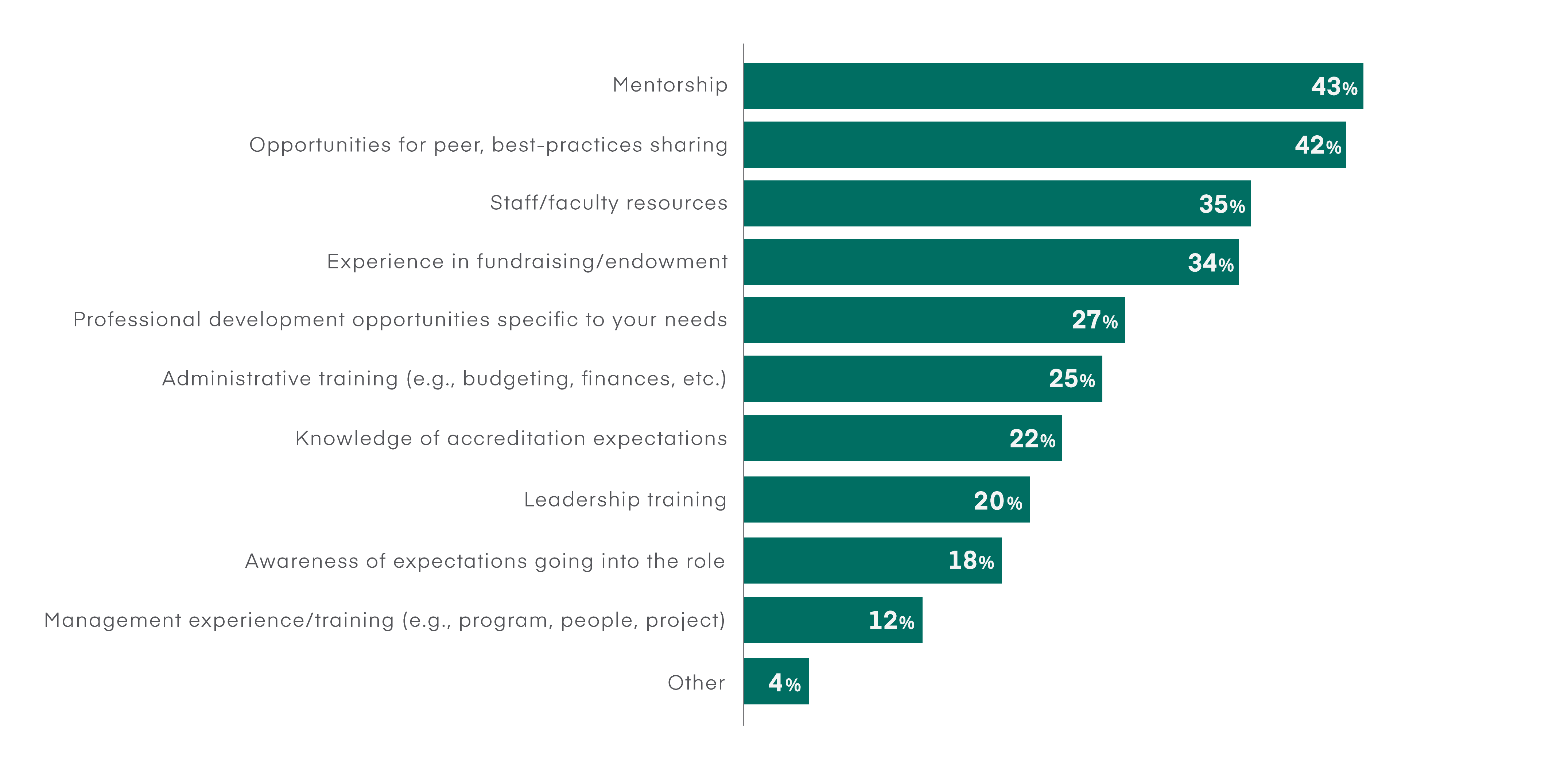
While both female and male deans equally value the top two resources, female deans expressed higher value for sharing best practices with peers compared to mentorship. A greater proportion of male deans (23 percent) desire more knowledge of accreditation expectations compared to their female counterparts (19 percent). One of the more significant differences between these two groups of deans is in awareness of the expectations that come with the role, for which 21 percent of male deans indicated a greater desire compared to only 13 percent of female deans.
We saw earlier that the senior administrator role serves as a common entry point into deanship, and as reported in this year’s Senior Administrators Survey, this role is more likely to be held by females, at 54 percent. This, combined with the finding that 66 percent of senior administrators identify accreditation management as a key responsibility, suggests that first-time female deans may have more extensive experience working on the types of tasks that are expected of deans.
Desired Resources of First-Time Deans: A Regional View
For optimal viewing experience, view on Tableau.
Shifting the lens to subregional differences, while keeping in mind the uneven representation among regions in this sample, Northern American deans stand out with their emphasis on fundraising and endowment, mirroring the importance of this activity in the region’s higher education context, compared to, for example, those in Europe and the Near East, where higher education is often subsidized. Among deans of Latin America and Caribbean schools, more than half (56 percent) expressed a desire for greater awareness of the expectations going into the role—significantly higher than deans in any other region in the sample. For deans in Asia, accreditation expectations are an important area where more resources and preparation would benefit first-time deans. Finally, exposure to best practices from peers is an area that deans across all regions greatly value, especially among deans in Asia Pacific, including Oceania, where 55 percent of responding deans signaled it as the most desired resource.
Several respondents shared other items that they hadn’t anticipated or that they wished they were better prepared for going into the role, including the political nature of the role and the human element involved in motivating and working with faculty and other internal stakeholders.
Challenges Uncovered
- I didn't expect how noisy the tails of the political spectrum are. It was the one part of being dean I was poorly equipped for.
- I unknowingly entered into a school where the faculty lacked motivation and collegiality. The rules in industry are different than the rules in higher education. I would have liked to have known what options I had when dealing with uncooperative faculty.
Best Practices Leveraged
- We have a full-time executive coach (former college president) at my institution that I meet with weekly and has helped tremendously. Between that [and] my associate and assistant deans, I feel I hit the ground running and did not really need any assistance navigating the role beyond what was provided to me institutionally.
- I had a great dean who mentored me for the last six years, and I learned a lot from him.
- I have deep expertise in culture and people management, which is hands down valuable getting started in my new situation—if I didn't have this, I would definitely need it!
Supporting Deans
In the words of one survey participant, the role of a dean “can be quite lonely,” underscoring the critical need for opportunities to engage with peers, build relationships, and receive mentorship. These elements are crucial as deans handle responsibilities as diverse as curriculum innovation, faculty development, and financial management. Within the vast AACSB global network, the ambitions and requirements of deans are varied, often reflecting the unique circumstances of their respective institutions. However, a common thread unites them: a commitment to elevating the quality, efficacy, and prestige of their schools.
Confronting an ever-evolving landscape, marked by challenges from technological advancements like AI to emerging political intricacies, AACSB stands as a pivotal resource. It offers the necessary advocacy, development opportunities, and industry insights to empower these academic leaders to be bold and effective in today’s complex educational and business environment.
About the SponsorAs an AACSB Business Education Alliance Member, Academic Partnerships (AP) is honored to help support AACSB in its important research initiative on the demographic trends, characteristics, challenges, and opportunities of business school deans. Founded in 2007, AP’s mission is to expand access to high-quality, affordable, and workforce-relevant education. AP assists primarily regional public universities in increasing their access and impact by making their academic programs available to students online, many of whom are underserved and nontraditional learners, such as working and adult students. AP brings single-minded dedication to student success, an integrated set of services, and data-driven performance to our collaboration with university partners. We provide universities with the support and infrastructure they need to expand their impact, while the university retains all control over admission decisions and program quality, standards, curriculum, and instruction. Although we support online programs across all disciplines, we are especially proud of helping universities across the country grow their portfolio of AACSB-accredited graduate and undergraduate online business programs, as they prepare tomorrow’s business leaders for success in a rapidly changing global marketplace. For more information on innovative online learning solutions, please visit www.academicpartnerships.com. |







